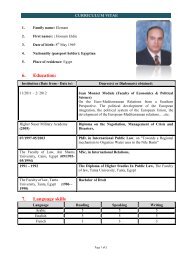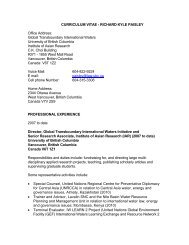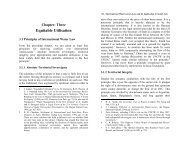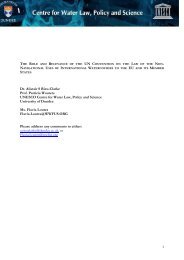Upreti, Trilochan, International Watercourses Law and Its Application ...
Upreti, Trilochan, International Watercourses Law and Its Application ...
Upreti, Trilochan, International Watercourses Law and Its Application ...
Create successful ePaper yourself
Turn your PDF publications into a flip-book with our unique Google optimized e-Paper software.
62 / <strong>International</strong> <strong>Watercourses</strong> <strong>Law</strong> <strong>and</strong> <strong>Its</strong> <strong>Application</strong> in South Asia Development <strong>and</strong> Codification of <strong>International</strong> <strong>Watercourses</strong> <strong>Law</strong> / 63with the World Bank (WB), United Nations DevelopmentProgramme <strong>and</strong> other bilateral donors assisting these efforts. 1142.7.4 The Indus Water Allocation Treaty, 1960 India-PakistanThis dispute was inherited from the time of unified India.However, the Indus treaty was concluded between the tworival states after the conflict over the consumptive use of waterof the Indus basin. This treaty was to resolve the problemscreated after the temporary interruption of water to Pakistanafter the partition of India. The main elements of theagreement were: 115 All the waters of the eastern rivers, theSultej, Beas, <strong>and</strong> the Ravi are made available for theunrestricted use of India <strong>and</strong> the western rivers the Indus,Jhelum <strong>and</strong> Chenab are made available for the unrestricted useof Pakistan.The canal structures had fallen in Indian Territory leavingPakistan without such an irrigation network. In order to enablePakistan to construct a huge irrigation network, Indiacontributed £ 62,000,000 <strong>and</strong> a substantial amount of moneywas provided from the World Bank, USA, UK, Germany <strong>and</strong>Australia to construct facilities inside Pakistan. The principlesadopted to settle this complex dispute, i.e. reasonable <strong>and</strong>equitable utilisation of the waters, to the satisfaction of bothstates, has major significance in the development of this area<strong>and</strong> the preservation of peace <strong>and</strong> security. However, actualallocations of the waters were 80 % to Pakistan <strong>and</strong> 20 % toIndia. It was not an equal but equitable division, <strong>and</strong> it has beenseverely criticised in India on the ground of inequality <strong>and</strong>favour to Pakistan. 116 From the viewpoint of needs (Pakistan’shuge population relying on the waters of these rivers) <strong>and</strong> prioruse (Pakistan’s use was greater than India) <strong>and</strong> the otherconsiderations spelled out in Article 6 of the UNCIW, thisdivision of the rivers has been regarded as equitable. The ruleof equitable utilisation dictated this resolution. It is worthmentioning that the treaty refused to take account of the‘drainage basin’ or ‘watercourse’ concept considering thewhole Indus a unit. Rather the rivers were divided between twostates. In recent months, in Jammu <strong>and</strong> Kashmir, an Indian statelegislature adopted a proposal to repudiate the treaty <strong>and</strong> askedthe federal government to negotiate it again, safeguardingIndian interests which were ignored earlier. 117 However, theresolution is regarded as one of the praiseworthy assignmentscarried out by the World Bank in such a complex water issue.2.7. 5 The Columbia River Treaty, 1961 USA-CanadaThe treaty primarily covered power development <strong>and</strong> floodcontrol aspects of the Columbia River Basin. Of the principlesestablished by this treaty, 118 some of them are regarded as thebasic foundation of IWL in regard to the co-operative <strong>and</strong> jointdevelopment of a shared river for mutual benefit. However, it isstated in the treaty that it would not be construed a precedent ora general principle of law. Rather, they thought that thesespecial arrangements cover the peculiar circumstances in theColumbia River basin between the two states.In spite of the above, this treaty succeeded in enunciating somemilestone principles, norms <strong>and</strong> criteria for the equitable <strong>and</strong>reasonable utilisation of IWC. Particularly, the idea ofdownstream benefits was first developed <strong>and</strong> recognised, costs114 J. Brunnee & S. J. Toope, “The Changing Nile Basin Regime: Does<strong>Law</strong> Matter ?” (2002) in 42 HILJ, pp. 105-159.115 419 UNTS, p. 100; also see R. K. Baxter, "The Indus Basin" in A.Garretson, et. al (eds), The <strong>Law</strong> of <strong>International</strong> Drainage Basins, NewYork: Oceana Pub., 1967, pp. 443-478.116 Supra note 22, pp. 280-285.117 Supra note 41, p. 3.118 Supra note 36, pp. 76-78; also see C. B. Bourne, “The Columbia RiverControversy” (1959) in 37 CBR, pp. 444-472. Generally, the benefitsaccrued from the works upstream are called ‘downstream benefits’.












